Even by Authentic standards, the D-28 Authentic 1931 takes things to the very origins of the D-28.
In fact, it is a replica of the very first D-28, which was given the serial number 48326 back in 1931. That instrument was recently purchased at Christie’s for the Martin Museum, during a public auction of guitars owned by Richard Gere. Almost immediately, Martin put it under the microscope of scrutiny, not to mention the CAT scan of the Smithsonian Institute, and used the results to create the D-28 Authentic 1931.
Specs Include: Hot hide glue construction; standard dreadnought shape; 1-7/8″ 12-fret vintage replica V neck of solid mahogany; period-correct ebony neck rod, fingerboard and bridge; Madagascar rosewood back and sides; Adirondack spruce top; Authentic Series scalloped braces with 1931 D X-brace position; fossilized ivory nut and glued-in long saddle; short-pattern diamonds and squares fretboard markers in solid abalone shell; wood fiber inlay including herringbone top purfling; thinner high gloss finish than modern Martins; slotted headstock; period-correct Martin brand stamp on back of headstock.
Big Boned but a Terrific Dancer
The D-28 Authentic 1931 is a big guitar that has a big voice, yet it is agile and graceful and truly a thing of beauty. It has a lot of air and open space inside that expansive tone bubble that effortlessly glows out around the guitarist as a strummed chord is left to swell and waver. The trebles are fat but pure, the bass is robust and warm as a bearskin coat, and the mid-range stays up front in a way 14-fret dreads never quite manage. I was holding back on my attack when strumming and flatpicking, as I recorded the example video. Even though the camcorder has an on-board compressor, at times the power and projection in that 12-fretter voice swamped the stereo mic.
A “standard” 12-fret Martin design has an elongated upper bout that reaches farther up the neck, not unlike a classical guitar. Although the 14-fret “orchestra model” Martins of the mid-1930s set the trend for modern, steel-string guitars, and have been copied by most every guitar manufacturer, that design has the upper bout squashed down to expose extra frets on the neck. As a result, 12-fret Martins have a fuller sound compared to their 14-fret counterparts, regardless of the body size.
When it comes to the dreadnoughts, the 12-fretters have a balance across all six strings, which makes them different from most other large guitars. There is no drop off as one sweeps across the A, D and G string. But there is a deep and expansive cavern of resonance underneath them. And that holds true for the D-28A 1931. Fingerpicking patterns are strong, well defined and ring clearly off the strings, at all levels of attack. The overall voice is that of a super-sized fingerpicker, one that also strums with great power and flatpicks like it’s hooked up to a stereo PA.
Lighter than one might guess a rosewood guitar can be, it produces an enormous amount of rich, yet open tone with little effort, but loves to be strummed hard as well. Having played the “Gere guitar” on different occasions, I can say the prototype of the D-28A 1931 actually has more horsepower under the hood. And it has perfect intonation up the neck, something pre-war Martins never quite achieve.
But it is also quite different from other 12-fret Martin rosewood dreads, which are typically heavier, and sound it. As with all the new Authentics, efforts to make them as close to originals as possible include a top, back and sides that are all thinner than Martin has used on previous vintage reissues, and the high gloss finish is thinner as well. If you are familiar with some of the vintage-esque mahogany 12-fretters that Martin has put out in recent years, like the Ditson 111, or the CS-D-18-12, and wished they would make a rosewood version with that ultra-light build and the open, sensitive dynamics that comes along with it – well, they have finally done so.
Vintage Vibes
During the First World War, the Ditson department store commissioned Martin to build an extra-large instrument that could hold down the bottom end in guitar ensembles, which were springing up during the Hawaiian music craze that was sweeping the nation. The result was the world’s very first slope-shouldered dreadnought.
Although they initially used the American spelling “dreadnaught,” the name came from the largest class of British battleships, which ruled the waves in those bygone days. And not without good reason. This new 12-fret behemoth dwarfed Martin’s traditional sizes, and put out a roar more like a battleship’s 12-inch guns then had ever been heard from the sound hole of a guitar.
When Ditson was scuttled and sank beneath the waves of the Great Depression, Martin decided to build the dreadnought size under their own brand. The mahogany D-1 and rosewood D-2 appeared in 1931 as “experimental models.” A D-2 was played by Arkie the Arkansas Woodchooper, a star entertainer on NBC’s National Barn Dance. But before Martin’s proto-dreads entered general production they were renamed the D-18 and D-28. One of each was made in 1931. The rest is history.
And history as been made yet again, as the very first D-28 sold out the door has found its way back to Martin and they chose it as the model for the new 12-fret D-28 Authentic.
One would be hard pressed to find a new guitar with as much vintage vibe as this one. With an ebony neck rod and shallow V neck, it feels like the body weighs more than the neck, and the body feels like it weighs hardly anything at all. Open, woody, somber in the lows, sunny in the highs, with a forecast for days of happy music-making to come, you will indeed be the envy of your neighbors if you have this brand new Studebaker of a vintage replica parked in your living room.
Every Check Mark on the List
Hyperbole aside, this really does have it all, in terms of vintage specs, if you can get by with only 12-frets clear of the neck. I love the wood fiber inlay on the body, which I assume is maple and ebony, although the dark stuff may be maple dyed black. In either case, the blonde stuff will age and darken right along with the spruce top. I love the fact it has thinner woods for the back, sides, and top, and a thinner finish than modern Martins. I love the extra-thin wings on the bridge. I love the thinner slotted headstock with no decal, and the fact the C.F. Martin & Co. brand is stamped in the back of the neck, with the same stamp that was used in the 1930s. And although I cannot see it, I love the fact that each Martin Authentic has had the maple bridge plate under the top meticulously shaped to replicate the one found on the specific pre-war Martin used as the model.
Sure, it would be great if these were made with Brazilian rosewood. But they would be so expensive Martin would have ended up recreating museum pieces with other museum pieces, which a very few people could afford to buy and actually play without fear of harming their investment.
The combination of Madagascar rosewood and Adirondack spruce is one of my all-time favorites. Madagascar is notably similar to Brazilian rosewood in looks and sound. It has that lush, rosewood bottom end, even if it tends to be a bit less thick or warm than Brazilian. And the high end tends to be a bit more clear and chimey than other rosewoods, but that is by no means a detriment.
Adirondack spruce is very stiff on the long grain and the cross grain, but as it breaks in and opens up, it offers spectacular headroom, so a player can really dig in. In terms of tone, it is highly reflective, and transparent, so it accentuates the sound of the tonewood rather than adding much in the way of filters. And it really brings out the bells and chimes of Madagascar, while allowing the detail of the sympathetic undertone and harmonic overtones to be heard with great clarity and definition.
Frankly, I think this combination of top and tonewood works very well with the standard dreadnought body size. This guitar is plenty dark down in the cellar and plenty fat across the mids. Other available rosewoods probably would have been so woofy there would be a considerable loss in terms of 3-D definition in the undertone. And the Madi-Adi ring thing on this model is at times breathtaking.
When it comes to vintage authentication, the 1-7/8″ neck was certainly required. And that is going to give many people pause, even if Martin always used that spacing on the 12-fret dreads up through Peter, Paul and Mary and beyond. But in the age of sleek electric guitar necks on acoustics, some players may feel this instrument is less a dreadnought than an aircraft carrier. But once their hands land on that wide ebony deck, they may just be pleasantly surprised.
The 1-7/8″ neck is rather shallow compared to other vintage necks, and carved so it does not feel as wide as it really is. But lest there be any doubt, it remains a handful for all but players with long fingers. I believe most will find it worth the extra effort, as they simply will never find this mammoth rosewood voice with its stellar tone anywhere else.
List price: $8,499
And that is one man’s word on…
The Martin D-28 Authentic 1931
All photos courtesy of “James O”, the lucky owner of a fine D-28A 1931.
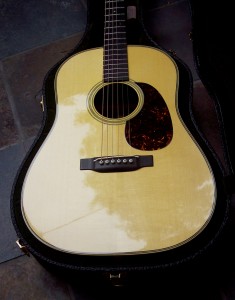
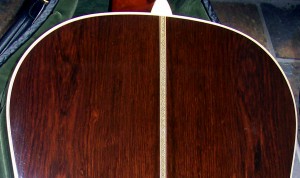
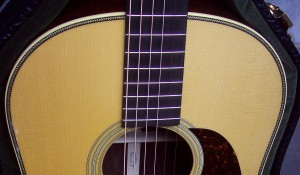
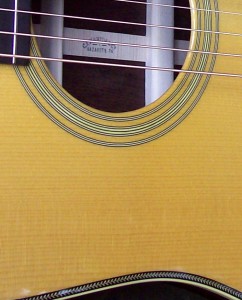
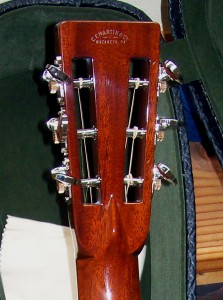
Very late to the party.
I have several Authentics, d1, ‘37 d28, ‘41 d28, (cs21-11-honorary Authentic).
The ‘31 D28 is everything described in onemanz review.i play fingerstyle as well as flatpicking. The guitar is loud, balanced, and its wider board actually helps with certain aspects of fingering and slide work over narrower boards. I have medium hands and this guitar is the most challenging for me to thumbwrap of any of my guitars, including the D1, but i can manage it.
If you like the neck and 12 fret neck, id highly recommend this one. It is, imho, very close to the D1, and , in fact, the ‘37 D28A, but a bit more. Effortless horsepower. 12 fret guitars, imho, have limitations regarding capoing. Besides 2 fewer frets before the body joint, the neck itself limits highest capo placement. Just a bit of a heads-up.
I think the 12 fret and neck width features are probably not for everyone. If you are one of the players that can live with these, then you are of the lucky few, like me.
I really love this guitar.
Quick question: Did the D-28 1931 Authentic come in two finishes – gloss and less glossy? This is based on a comment above. Curious.
Thanks.
Hello. Sorry for the late reply as August is always a busy time. That is correct. The Vintage Gloss finish debuted in 2015. So, the D-28A 1931 made in the first two years of production have the full high gloss finish. Those available in 2015 and 2016 have the Vintage Gloss, which is buffed to a duller sheen, like Style 28 guitars made in the pre-war era. If you search for vintage gloss in my search bar you will find more information, including the conversation with Tim Teel about the more-authentic finish.
I have owned this D-28 Authentic VTS for 6 months now and really appreciate your review and agree with your description of the richness of the tone. I have played a 1945 D-18 for most of my life and this 12 fret has a richer tone. I know that it is hard to compare a mahogany backed instrument with one made with a Madagascar back and sides but I can say that the tone and feel of the instrument is better than my holy grail, the 1945 D-18 left to me by my father. I love the width of the neck at 1 7/8 inches. I exclusively finger pick and have medium sized hands but this added width makes it so much easier to move around the fret board. I also have a D-45 with the standard width neck and have no problem moving from the D-45 (I use it with an amp) and this D-28 vintage that does not have an amp. I also like the waverly tuners and find them very precise. My D-28 Authentic was made in 2013 and I am the second owner. The tone just keeps growing and the balance of the high and low notes is perfect to my ear. I must say that I especially appreciate the rich base. I have never played a better sounding guitar and no longer miss the D-18 that I passed on to my nephew. This instrument has met all my expectations and is a joy to play. I have been complimented with the richness of the sound when I play at the live cafe here in South Korea. It was a joy to play there until they were shut down by the virus. I would be going crazy if I did not have this truly amazing guitar to play every day of the lock down. The guitar also came with the high end 500 series case, which in many ways is a copy of the Greib case made in the 30s. That includes the dark black bumpy surface. All in all Martin did a real service to us lovers of fine guitars by reissuing this almost exact (only the wood on the back and side is Madagascar not Brazilian Rosewood) copy of the original D-28 12 fret guitar Including making a copy of the neck profile with the wider nut.
After researching for months and playing several Martin Authentics, I found the one I wanted to take home. It is the Martin D-28 Authentic 1931 with the NON-VTS top and high-gloss finish. I played other Authentics with VTS and for my ear, they were a bit too brittle and dry on top of new Red Spruce’s similar properties. I like what happens to Sitka Spruce with the VTS treatment A LOT. Red Spruce, not so much, but to each his or her own.
I have not owned a 12-fret dreadnought before this one. I have had it for about a week now. Spoon’s review was absolutely correct and mirrors my impression of the guitar. Yes, she is “Big Boned”, but Man can she dance and sing! The neck carve really makes the 1 7/8″ neck easy to play. It does not feel like a baseball bat in my fretting hand. The depth, breadth and balance of the tones produced are magical to me. It gladly accepts every playing style I have tried on her and does not compromise. I wanted a big, deep voice and “old school” looks and got both in this guitar. I saw Don McLean play “Vincent” back in the the 1970’s, a solo performance using a Martin 12-fret dreadnought, and that tone stuck in my head ever since. My D-28 Authentic 1931 scratches that itch, finally! This is THE Martin I was missing among my family of Martin guitars.
Thank you Spoon, for helping me to decide on this beautiful instrument! You nailed the review.
Awesome!! That is my impression of that model. And of the news that you went and acquired one for yourself. Congratulations! I am sure the two of you will be very happy together.
I recently sold my gloss model and bought the VTS version and I am so glad that I did. It sounds amazing.
I have had mine for 2 years or so now and the top has become more responsive, and can be played with a lighter touch. I found the neck width difficult at first, but now find it fairly comfortable. It is the most resonant guitar I have played,and everyone who hears it is amazed. There’s little doubt that 12 fret guitars have a fuller, warmer tone, and I am so happy that I bought mine. If they ever make an authentic OO sized 12 fret model, I would be overjoyed and buy one in an instant.
Be careful what you wish for, Mike. On Thursday Martin is releasing the 00-18 Authentic 1931, a 12-fret 00. Anticipation is high.
But how long before we see one in rosewood, almost certainly a 00-21? Hard to say. But they are doing a 12-fret 000, a 000-30, which I expect to see in January 2017. So it will probably be sometime before we see the rosewood 00.
I’ve owned my ’31A for just over a year and a half. It is, along with my CS-D18-12, my favorite Martin. I agree that this review really gets the tonal description right. I would reiterate that the nut width is a small hill to climb, and my medium sized hands have no difficultly negotiating this fretboard. From day one I have felt extremely comfortable with this instrument. Also, I honestly don’t think I’ve come across a guitar that offers so much sonically at every register. The tone on the ’31A is incredibly rich and warm, while also being very articulate and defined from string to string. I just hope that people who might initially be put off by the idea of a larger than usual nut width don’t miss out on a spectacular guitar experience without taking the time to try one out.
That is great to hear, Stephen. Thanks for the input and welcome to One Man’s Guitar. It is indeed one of the most impressive acoustic guitars available anywhere in the world. Congratulations!
James O. comment pretty much says it all. I will just add that this guitar sounds like a six string, grand piano. I would not prepared to declare my OM or 000 size acoustics as DOA, but nothing sounds quite like the Martin 1931 D-28-A…even those guitars in its ‘weight class’, like the Gibson J-200.
This guitar is so articulate and clear that it makes my 000-42 sound like its being played under a blanket. A truly remarkable guitar.
Wonderful guitar….sounds almost like a 12-string, Sonorous.
I am the owner of the D-28 Authentic 1931 whose photos appeared on the UMGF and now on your website. Your review is very comprehensive and pretty much covered all the bases. I would also say that I have fairly small hands and I am really having no trouble negotiating the neck at all and this is the widest nut width I have ever played.
You describe the sound bang on. The sound just oozes out of this guitar like warm honey from a bee hive. Even my wife commented on the “smooth” sound and she is not usually interested in the nuances of guitar sound.
At this point I think my “grail ” search may be over, and I also think these New Authentics may just give their ancestors a real run for the money.
Great write up and good luck with all.
Hi James. Thanks very much for your comments! You have my envy for having acquired one of the first examples of a D-28A 1931 to get out the factory door.
I think it is an exceptional guitar and from what you have said here and on the Unofficial Martin Guitar Forum, you seem to agree. It is nice to hear that I am on the mark in my attempt to offer unbiased reviews of quality guitars.
I hope you enjoy your new guitar for many years to come.